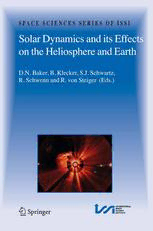
Solar Dynamics and Its Effects on the Heliosphere and Earth PDF
Preview Solar Dynamics and Its Effects on the Heliosphere and Earth
SOLAR DYNAMICS AND ITS EFFECTS ON THE HELIOSPHERE AND EARTH SpaceSciencesSeriesofISSI Volume22 The International Space Science Institute is organized as a foundation under Swiss law. It is funded through recurrent contributions from the European Space Agency, the Swiss Confederation, the Swiss National Science Foundation, and the University of Bern. For moreinformation,seethehomepageathttp://www.issi.unibe.ch/. SOLARDYNAMICSANDITSEFFECTS ONTHEHELIOSPHEREANDEARTH Editedby D.N.BAKER LaboratoryforAtmosphericandSpacePhysics, BoulderCO,USA B.KLECKER Max-Planck-Institutefu¨rextraterrestrichePhysik, GarchingGermany S.J.SCHWARTZ BlackettLaboratory,ImperialCollegeLondon, London,UK R.SCHWENN Max-PlanckInstitutfürSonnensystemforschung, Katlenburg-Lindau,Germany R.VONSTEIGER InternationalSpaceScienceInstitute(ISSI), Bern,Switzerland ReprintedfromSpaceScienceReviews,Volume124,Nos.1–4,2006 A.C.I.P.CataloguerecordforthisbookisavailablefromtheLibraryofCongress ISBN:978-0-387-69531-0 PublishedbySpringer P.O.Box990,3300AZDordrecht,TheNetherlands SoldanddistributedinNorth,CentralandSouthAmerica bySpringer, 101PhilipDrive,Norwell,MA02061,U.S.A. Inallothercountries,soldanddistributed bySpringer, P.O.Box322,3300AHDordrecht,TheNetherlands Printedonacid-freepaper AllRightsReserved (cid:1)c 2007Springer Nopartofthematerialprotectedbythiscopyrightnoticemaybereproducedor utilisedinanyformorbyanymeans,electronicormechanical, includingphotocopying,recordingorbyanyinformationstorageand retrievalsystem,withoutwrittenpermissionfromthecopyrightowner PrintedintheNetherlands TABLEOFCONTENTS Foreword vii–viii SECTIONI:SOLARDYNAMICS A.G.KOSOVICHEVandT.L.DUVALL,JR/ActiveRegionDynamics. RecentHelioseismologyResults 1–12 N.O.WEISS/SunspotStructureandDynamics 13–22 L.GOLUB/CoronalDynamicsandtheAIAonSDO 23–33 ESTER ANTONUCCI / Wind in the Solar Corona: Dynamics and Composition 35–50 SECTIONII:SOLARWINDCHAIN R.SCHWENN/SolarWindSourcesandTheirVariationsOvertheSolar Cycle 51–76 THOMAS H. ZURBUCHEN / Heliospheric Physics: Linking the Sun to theMagnetosphere 77–90 RUMINAKAMURA/SubstormsandTheirSolarWindCauses 91–101 J.BIRN,M.HESSEandK.SCHINDLER/ModelingoftheMagnetospheric ResponsetotheDynamicSolarWind 103–116 M. LESTER, S. E. MILAN, G. PROVAN and J. A. WILD / Review of Ionospheric Effects of Solar Wind Magnetosphere Coupling in the ContextoftheExpandingContractingPolarCapBoundaryModel 117–130 SECTIONIII:CMECHAIN S.E.GIBSON,Y.FAN,T.TO¨RO¨KandB.KLIEM/TheEvolvingSigmoid: Evidence for Magnetic Flux Ropes in the Corona Before, During, and AfterCMEs 131–144 NAT GOPALSWAMY / Properties of Interplanetary Coronal Mass Ejections 145–168 H.E.J.KOSKINENandK.E.J.HUTTUNEN/GeoeffectivityofCoronal MassEjections 169–181 IOANNISA.DAGLIS/RingCurrentDynamics 183–202 J.GOLDSTEIN/PlasmasphereResponse:TutorialandReviewofRecent ImagingResults 203–216 M. WILTBERGER and D. BAKER / End-to-End Modeling of the Solar TerrestrialSystem 217–231 SECTIONIV:SEPCHAIN R. P. LIN / Particle Acceleration by the Sun: Electrons, Hard X-rays/ Gamma-rays 233–248 PETER J. CARGILL, LOUKAS VLAHOS, RIM TURKMANI, KLAUS GALSGAARDandHEINZISLIKER/ParticleAccelerationinaThree- DimensionalModelofReconnectingCoronalMagneticFields 249–259 M. I. DESAI, G. M. MASON, J. E. MAZUR and J. R. DWYER / The Seed Population for Energetic Particles Accelerated by CME-driven Shocks 261–275 JOEGIACALONEandJO´ZSEFKO´TA/AccelerationofSolar-Energetic ParticlesbyShocks 277–288 B.KLECKER,E.MO¨BIUSandM.A.POPECKI/SolarEnergeticParticle ChargeStates:AnOverview 289–301 R.A.MEWALDT/SolarEnergeticParticleComposition,EnergySpectra, andSpaceWeather 303–316 SECTIONV:COMMONALITIES GERHARD HAERENDEL / Commonalities Between Ionosphere and Chromosphere 317–331 STEVEN J. SCHWARTZ / Shocks: Commonalities in Solar-Terrestrial Chains 333–344 J.BU¨CHNER/TheoryandSimulationofReconnection. InmemoriamHarryPetschek 345–360 MARKUSJ.ASCHWANDEN/TheLocalizationofParticleAcceleration SitesinSolarFlaresandCMEs 361–372 FOREWORD TheSOHOandClustermissionsformasingleESAcornerstone.Yettheyobserve verydifferentregionsinoursolarsystem:thesolaratmosphereononehandandthe Earth’smagnetosphereontheother.AtthesametimetheUlyssesmissionprovides observationsinthethirddimensionoftheheliosphere,andmanyothersaddtothe picturefromtheLagrangianpointL1totheedgeoftheheliosphere.Itwasouraim totietheseobservationstogetherinaddressingthetopicofSolarDynamicsandits Effects on the Heliosphere and Earth with a workshop at the International Space ScienceInstitute(ISSI),undertheauspicesoftheInternationalLivingWithaStar (ILWS) program. It started out with an assessment and description of the reasons for solar dynamics and how it couples into the heliosphere. The three subsequent sections were each devoted to following one chain of events from the Sun all the way to the Earth’s magnetosphere and ionosphere: The normal solar wind chain, thechainassociatedwithcoronalmassejections,andthesolarenergeticparticles chain.Thefinalsectionwasdevotedtocommonphysicalprocessesoccurringboth at the Sun and in the magnetosphere such as reconnection, shock acceleration, dipolarisationofmagneticfield,andothers. This volume is the result of an ISSI Workshop held in April 2005. An international group of about forty experimenters, ground-based observers, and theoreticians was invited to present and debate their data, models, and theories in an informal setting. The group was convened by Madhulika Guhathakurta (NASAHQ),GerhardHaerendel(thenatIUBremen),HermannOpgenoorth(ESA- ESTEC),RogerM.Bonnet,GötzPaschmann,andRudolfvonSteiger(allISSI). Itisapleasuretothankallthosewhohavecontributedtothisvolumeandtothe workshopsingeneral.Firstofall,wethanktheauthorsforwritinguptheircontri- butions.Allpaperswerepeer-reviewedbyreferees,andwethankthereviewersfor theircriticalreports.WealsothankthedirectorateandstaffofISSIforselectingthis topicforaworkshopandfortheirsupportinmakingithappen,inparticularRoger M.Bonnet,BrigitteFasler,VittorioManno,SalibaF.Saliba,IrmelaSchweizer,and SilviaWenger. December2006 D.N.Baker,B.Klecker,S.J.Schwartz,R.SchwennandR.vonSteiger SpaceScienceReviews(2006)124:vii–viii (cid:1)C Springer2007 viii FOREWORD Groupphotograph;fromlefttoright(nosetipcounts):MarkusAschwanden,RainerSchwenn,Hannu Koskinen,HermannOpgenoorth,AlexanderKosovichev,PeterCargill,MarkLester,EsterAntonucci, JohnLeibacher,RudolfvonSteiger,SteveSchwartz,JoachimBirn,RumiNakamura,DanBaker,Mihir Desai,Roger-MauriceBonnet,LikaGuhathakurta,SarahGibson,ThomasZurbuchen,SilviaWenger, BerndtKlecker,JerryGoldstein,BrigitteFasler,YannisDaglis,RichardMewaldt,JonLinker,Go¨tz Paschmann, Ruth Esser, Jo¨rg Bu¨chner, Bob Lin, Dave Sibeck, Joe Giacalone, Nat Gopalswamy, BernhardFleck,MikeWiltberger,GerhardHaerendel(picturetakenbySteinHaaland). ACTIVEREGIONDYNAMICS RecentHelioseismologyResults A.G.KOSOVICHEV1,∗andT.L.DUVALL,JR2 1StanfordUniversity,Stanford,CA94305,USA 2LaboratoryforAstronomyandSolarPhysics,NASA/GoddardSpaceFlightCenter,Greenbelt, MD20771,USA ∗ ( Authorforcorrespondence,E-mail:[email protected]) (Received20October2005;Acceptedinfinalform7March2006) Abstract. Newmethodsoflocalhelioseismologyanduninterruptedtimeseriesofsolaroscillation data from the Solar and Heliospheric Observatory (SOHO) have led to a major advance in our understandingofthestructureanddynamicsofactiveregionsinthesubsurfacelayers.Theinitial results show that large active regions are formed by repeated magnetic flux emergence from the deepinterior,andthattheirrootsareatleast50Mmdeep.Theactiveregionschangethetemperature structureandflowdynamicsoftheupperconvectionzone,forminglargecirculationcellsofconverging flows.Thehelioseismicobservationsalsoindicatethattheprocessesofmagneticenergyrelease,flares andcoronalmassejections,mightbeassociatedwithstrong(1–2km/s)shearingflows,4–6Mmbelow thesurface. Keywords: Sun:activity,Sun:heliseismology,Sun:interior,Sun:magneticfield,sunspots 1. Introduction Active regions are the most important source of heliospheric disturbances. They are formed by magnetic fields generated by dynamos in the convection zone and emergingfromtheSun’sinterior.Magneticfieldtopologyandmagneticstressesin thesolaratmospherearelikelybecontrolledbymotionsofmagneticfluxfootpoints inthesub-photosphere.However,thedepthofthesemotionsisunknown.Twisting and shearing of the magnetic field of active regions by subphotospheric motions as well as its interaction with new emerging magnetic field result in flares and CMEs. Helioseismology provides tools for diagnosing the subsurface structures and dynamics, and allows us to investigate the origin of solar magnetic fields, formation and evolution of active regions, the relationship between the internal dynamics and activity, and to develop methods for predicting the emergence and evolution of active regions and their activity. The helioseismic investigation of the dynamics of active regions has only just begun, and the results are still very preliminary. However, we are beginning to develop a new understanding of the lifecycle of active regions, their emergence, evolution and decay, as well as the relationshipbetweentheiractivityandinternaldynamics.Specifically,someofthe questionsthatarestudiedbylocalhelioseismologyare: SpaceScienceReviews(2006)124:1–12 DOI:10.1007/s11214-006-9112-z (cid:1)C Springer2007
